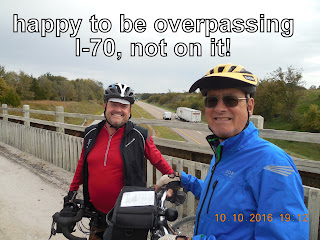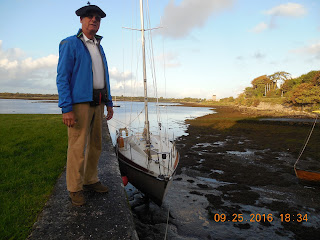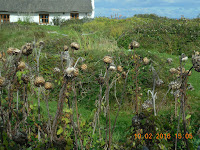About
the Trail
The
KATY Trail is the longest developed rail-to-trail system in the US
(https://www.mostateparks.com/park/katy-trail-state-park
). The name KATY is derived from the name of the former rail line,
the Missouri-Kansas-Texas Railroad (MKT). The MKT railroad abandoned
the line in the early 1980s' due to decline of it's profitability.
The National Trails System Act made it possible to transfer the
management of the rail corridor from the private sector while
preserving the right-of-way for future transportation possibilities,
and the rail-bed was redeveloped as a bicycling trail. The
redevelopment included new bridges, sanitation facilities,
restoration of historic rail depots, numerous information placards,
and pleasant parks and museums along the route.
The opening of the KATY Trail was a stimulus for the development of new commercial enterprises to serve the cycling public, such as brew pubs, restaurants, ice cream parlours, B&Bs, campgrounds, and bike shops.
The opening of the KATY Trail was a stimulus for the development of new commercial enterprises to serve the cycling public, such as brew pubs, restaurants, ice cream parlours, B&Bs, campgrounds, and bike shops.
Much
of the trail follows closely by the Missouri River, affording
delightful views of “Big Muddy”.
We particularly enjoyed the informative placards describing the history of the original inhabitants (Osage Nation), European explorers and fur traders (French, Spanish and British), and eventual US occupation and expulsion of the Osage. Historical highlights include the Daniel Boone settlement and the Lewis and Clark Discovery Expedition.
There were unique and unexpected sights along the way.
We particularly enjoyed the informative placards describing the history of the original inhabitants (Osage Nation), European explorers and fur traders (French, Spanish and British), and eventual US occupation and expulsion of the Osage. Historical highlights include the Daniel Boone settlement and the Lewis and Clark Discovery Expedition.
There were unique and unexpected sights along the way.
The trail bed is well-surfaced with packed fine gravel. There were only a few local areas damaged by recent flooding. The grade is minimal, as dictated by its former use as a rail bed. The narrow right-of-way is mostly treed, but sections do pass through open farmlands, exposed to sun and wind. Many small and larger towns were served by the rail line, and we cycled into or through several of these historic communities.
About
the Tour
This
was a guided and van-supported bicycle tour organized by Wilderness
Voyageurs (www.wilderness-voyageurs.com
). The van shuttled the participants from our meeting place in St.
Charles, MO, to the start of our cycle ride at Clinton, MO. We
cycled back to our vehicles in St. Charles. We enjoyed the services
of two trip leaders; James Oerding and John Buelhorn.
One drove the van ahead to set up our “pit stops” and a picnic lunch. Lunches were delicious; smoked turkey salad, humus, baked beans, cheeses, deli sausage, cold cuts, fresh vegetables and fruit, as well as the usual snack foods and drinks. The van also served as “Sag Wagon” and was a mobile bike repair shop. The other guide cycled with the group and looked after the inevitable mishaps (several falls required first aid) and malfunctions (most commonly flat tires). Each participant was provided with printed route descriptions and a GPS programmed with the route (an alarm sounded when a turn was missed).
Sleeping
and Eating
Lodgings
and locations for evening meals were reserved by Wilderness
Voyageurs. They varied from B&Bs in historic buildings, to
historic Hotels, to modern mega-hotels. The B&Bs were, by far,
the most interesting. They were all welcoming and comfortable.
Evening meals were sometimes Group Events in interesting venues
arranged by Wilderness Voyageurs and other times on our own; a good
combination.
About
the Participants
There
were 8 cyclists in our group, including us. Ages ranged up to 82
years. There was one father-daughter team. One cyclist from
California, one from Texas, one from Wisconsin, one from Indiana,
two from Maryland, and us from Nova Scotia. All riders were
experienced and fit.
We
became acquainted with our trip leaders and fellow cyclists during
the shuttle from St Charles to
Clinton. During the 38 miles cycled on this day, we passing the
highest point on the trail (952 ft above sea level).
Later,
we paused at
the restored Victorian-style 1896 Sedalia rail depot. We left the
KATY trail to the centre of Sedalia and our lodging at the historic
and comfortable Bothwell Hotel (www.hotelbothwell.com
), where President Harry Truman once slept. After a welcome hot
bath, the group gathered at Fitters 5th Street Pub for brews, dinner
and conversation.
Sedalia is the cradle of classical ragtime since Scott Joplin composed Maple Leaf Rag here.
Day 2
Sedalia is the cradle of classical ragtime since Scott Joplin composed Maple Leaf Rag here.
Day 2
Today
we cycled 50 miles from Sedalia to Rocheport, one of many cities and
locations with French names. We paused at the remains of a railway
roundhouse at one of the junctions with branch lines.
We learned about the history of the railroad; construction, boom, repeated flooding, economic decline and eventual decay. There is a splendid exhibit about the Discovery Expedition of Lewis and Clark, including full-size replicas of their keel-boat and pirogues.
The School House B&B is in a wonderfully restored three-story school building, listed on the National Register of Historic Places. There are eleven guest rooms, a multi-course breakfast, and delightful amenities (including en suite jacuzzi) and wonderful hospitality (www.schoolhousebb.com ).
We were ready for a set dinner at the Grocery Store Restaurant, where the proprietor is also the Rocheport Mayor.
We
stopped in Boonville at the KATY Trail Museum, housed in a newly
renovated rail-side warehouse.
We learned about the history of the railroad; construction, boom, repeated flooding, economic decline and eventual decay. There is a splendid exhibit about the Discovery Expedition of Lewis and Clark, including full-size replicas of their keel-boat and pirogues.
The School House B&B is in a wonderfully restored three-story school building, listed on the National Register of Historic Places. There are eleven guest rooms, a multi-course breakfast, and delightful amenities (including en suite jacuzzi) and wonderful hospitality (www.schoolhousebb.com ).
We were ready for a set dinner at the Grocery Store Restaurant, where the proprietor is also the Rocheport Mayor.
We
met the author of the Guide
to the KATY Trail, Brett Dufur
(www.pebblepublishing.com/complete_katy_trail_guidebook.htm
)
Day 3
Along the way we marvelled at the Manitou Bluffs (dolomite and sandstone), the Native American Petroglyphs, the ancient Burr Oak Tree, and learned about harvesting soybeans.
We cycled 38 miles from Rocheport and crossed the Missouri River to the state capital, Jefferson City.
Day 4
Day 3
Along the way we marvelled at the Manitou Bluffs (dolomite and sandstone), the Native American Petroglyphs, the ancient Burr Oak Tree, and learned about harvesting soybeans.
We cycled 38 miles from Rocheport and crossed the Missouri River to the state capital, Jefferson City.
Our
Capital Plaza Hotel is next to the beautiful State Capital building.
Our guided tour of the capital building revealed beautiful murals and
stained glass. The state history museum is informative.
Day 4
Highlights
included
Daniel Boone's final resting place and “the judgment tree” where
he held court when he was a territorial judge.
Our lodging at the Hermann Crowne Suites (www.hermanncrownhotel.com ) included an en suite Jacuzzi tub, most welcome after cycling 173 miles over the first four days.
Day 5
There
were two crossings
today of The Big Muddy while cycling 47 miles from Jefferson City to
Hermann, a thriving town of German descendants. The many restaurants,
wurst houses, micro breweries and wineries make for abundant happy
tourists, but the streets are far from busy.
Our lodging at the Hermann Crowne Suites (www.hermanncrownhotel.com ) included an en suite Jacuzzi tub, most welcome after cycling 173 miles over the first four days.
Day 5
We
cycled 37 miles starting with a Big Muddy crossing and carrying on to
Augusta where we enjoyed a micro brew
before checking into our lovely
200 year old restored Apple Gate B&B (www.applegate-inn.com
) . Our charming hostess explained the operation of the en suite
sauna, which was put to use immediately!
We thoroughly enjoyed all aspects of the splendid hospitality at the Apple Gate B&B!
A stroll around Augusta revealed some interesting scenery.
we cycled 27 miles from Augusta into St. Charles, our starting point, where our vehicles were awaiting us. Along this section there is a gradual transition from rural to urban scenery and increase in population density. We had not seen that many automobiles in a week on the KATY trail!
Upon assembling at our terminus, we congratulated each other for our achievements on the KATY trail!
We enjoyed a farewell lunch at Henrick's BBQ,
saying our goodbyes to our new cycling friends and, as usual, promising to meet again on another cycling trail! Perhaps we will!
We thoroughly enjoyed all aspects of the splendid hospitality at the Apple Gate B&B!
Our
delicious Farewell Dinner was at the Conference Centre and we were
delighted to have an after dinner lecture about South
America.
A stroll around Augusta revealed some interesting scenery.
Day
6
After
a healthy and hardy breakfast provided by Lynn at Apple Gate B&B, we cycled 27 miles from Augusta into St. Charles, our starting point, where our vehicles were awaiting us. Along this section there is a gradual transition from rural to urban scenery and increase in population density. We had not seen that many automobiles in a week on the KATY trail!
Upon assembling at our terminus, we congratulated each other for our achievements on the KATY trail!
We enjoyed a farewell lunch at Henrick's BBQ,
saying our goodbyes to our new cycling friends and, as usual, promising to meet again on another cycling trail! Perhaps we will!
Here
is another KATY blog that you might enjoy.
Peter
and Catherine,
now aboard S/V Charlotte D, laying Iles de Saintes, Guadeloupe,
French West Indies. Our sailing adventures are recorded at
www.svcharlotted.blogspot.com
“It is by riding a bicycle that you learn the contours of a country best, since you have to sweat up the hills and coast down them. Thus you remember them as they actually are, while in a Motor car only a high hill impresses you, and you have no such accurate remembrance of country you have driven through as you gain by riding a bicycle.” Ernest Hemingway
“It is by riding a bicycle that you learn the contours of a country best, since you have to sweat up the hills and coast down them. Thus you remember them as they actually are, while in a Motor car only a high hill impresses you, and you have no such accurate remembrance of country you have driven through as you gain by riding a bicycle.” Ernest Hemingway






















































































































